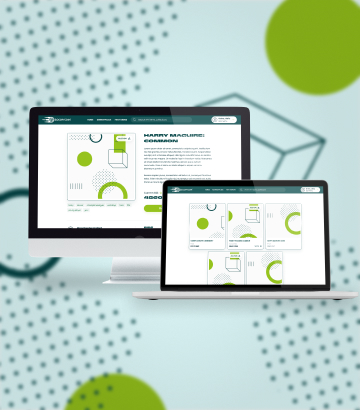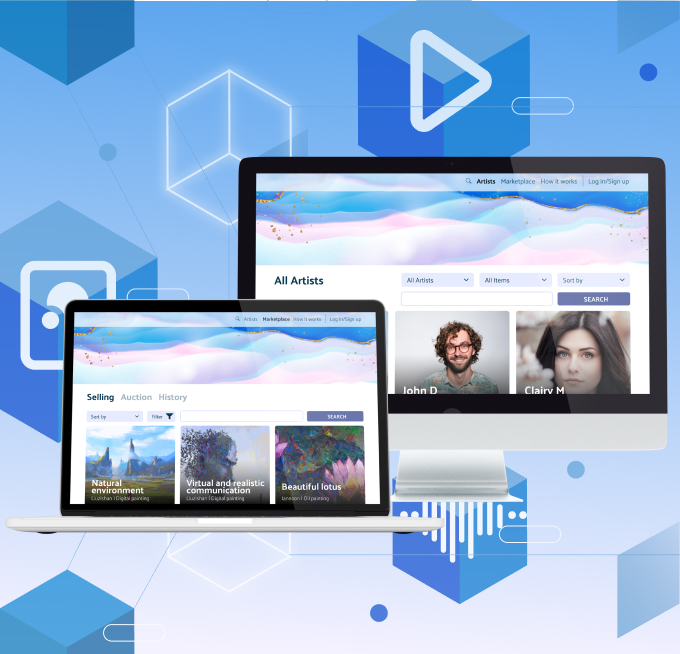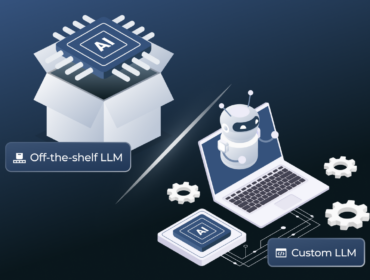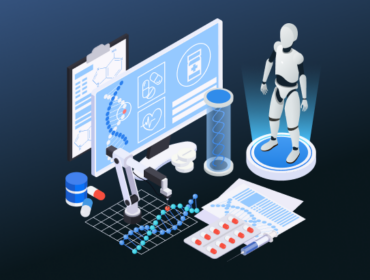The global NFT market size is expected to grow from USD 3.0 billion in 2022 to USD 13.6 billion by 2027, at a Compound Annual Growth Rate (CAGR) of 35.0% from 2022 to 2027.
Most NFTs sell out instantly, and the most famous NFTs sell for around $70 million. This hype is supported by celebrities tokenizing their music, paintings, memes, short videos, logos, computer code, and so on.
The main beneficiaries of the NFT market are platforms that provide users with the simplest possible and most secure experience possible when purchasing and selling NFTs. In this article, we will briefly explain what NFT marketplaces are, how to develop them, and how much does nft marketplace development cost in 2022.
What is an NFT?
An NFT (non-fungible token) is a digital token stored in a blockchain that acts as a unique certificate. It proves ownership for physical or virtual items such as audio tracks, photos, videos, etc.
A token is an element of a blockchain or a digital record that can be compared to securities or stocks in the real world. There are fungible tokens, partially fungible and non-fungible (NFT token).
Let’s look at examples.
Fungible Token
If you take a banknote with a face value of a thousand dollars on credit, and then give the same one, then there will be no difference. Although the banknotes are different (each with its own number), they are equivalent and replace each other. Cryptocurrency works the same way in the digital world. Any bitcoin is equal to the same, because each has a fungible token.
Partially Fungible Token
If you buy a train ticket, it will not be unique: other passengers have the same tickets that can be exchanged. But if you take a train ticket, where a specific place is indicated, then there can be no other such place. In the digital world, this ticket would combine the characteristics of a fungible token (passengers can exchange tickets for one train and still get to their destination) and non-fungible, because it specifies a specific seat that is unique on the train. Therefore, a train ticket with a specific location would receive a partially-fungible token.
Non-Fungible Token (NFT)
If you buy a painting that is sold in a single copy, you can no longer replace it with a copy – this is another work of art with its own characteristics. When such a work exists only in the digital world, the object is assigned a non-fungible token (NFT) and can be bought or exchanged on the NFT art marketplace.
To put it simply – NFTs are crypto assets. And while an NFT is not a cryptocurrency, which you can immediately spend, it is an object that has passed verification, ended up in a blockchain, and now belongs to you, which means it can be sold. An NFT cannot be destroyed or replaced with another token. The owner of a token becomes the owner of the unique object that it represents. And this property is reliably protected – after all, all transaction records are in the blockchain system for that NFT.
An example of an NFT that has taken the world by storm is the CryptoKitties game. Here they buy digital pets with a unique token. NFT crypto cats are bred – and produce a new kitten. The blockchain code here works like a genetic one: each new cat will be the one and only.
How does the NFT Marketplace Work?
The NFT Marketplace is an adaptive online platform that provides access to offers for the sale and purchase of non-fungible tokens.
To purchase and sell NFTs, you need special platforms that allow you to issue, store, and trade non-fungible tokens. Today, the market is dominated by OpenSea, Rarible, Superfarm, and Mintable. These marketplaces create NFTs using smart contracts which add unique information and parameters to tokens.
A well-designed NFT marketplace will allow you to establish a close relationship between the seller and customer. Users have access to a digital catalog and a personal account, with the help of which, it is possible to carry out safe and fast transactions. Non-fungible tokens can be sold at a fixed price or through auctions.
An NFT marketplace works like any other online store. The customer registers on the platform, creates a digital wallet, and after that, can store NFTs and cryptocurrencies.
Top NFT Marketplaces
Here are some of the most popular NFT marketplaces to get inspired by:
OpenSea
The world’s largest NFT marketplace by total value of digital assets. Here, every day, 20 thousand users make about 50 thousand transactions for a total amount of more than $40 million.
In the Art category alone, you can find more than 1.3 million lots, the most expensive of which is sold for 5,000 ETH. At the time of this writing, 1 ETH is worth just over $2,900. The piece is a quote from Henry Ford printed in block type on a uniform gray backdrop.
Also on OpenSea you can find huge deposits of musical compositions, virtual worlds, collectible cards for different games, just collectibles, a variety of digital sports-related items, as well as lots that are difficult to find in a specific category. Most of them are strange GIFs.
The marketplace works with three blockchains – Ethereum, Polygon and Klaytn – each of which supports the creation of NFTs.
Axie Infinity
According to the DappRadar analytical service, almost 38,000 players in Axie Infinity provide a daily trading volume of over $28 million every day. The objects of purchase and sale here are creatures that can be bred and used in the gameplay, as well as game territories, items, etc.
The game uses several monetization methods based on commission payments for buying/selling and certain in-game actions.
Rarible
Rarible is a popular platform that anyone can access. It sells photos, musical compositions, games, meme tokens. Rarible is based on the Ethereum blockchain. The interface is simple for all users.
Until 2022, the Rarible marketplace charged users a commission for minting each NFT. The amount was quite significant and ranged from 100 to 1000 dollars. However, now the policy of the site has changed. The new Free Minting feature allows you to mint NFT tokens for free, the commission is charged only at the time of sale.
Rarible users can also receive royalties from each subsequent sale of their token. Everyone sets its size independently, while filling out the token card. Funds are credited at the moment when the NFT passes to another owner.
NiftyGateway
The NiftyGateway platform has convenient functionality for buying and selling NFTs, as well as an impeccable reputation. It was bought by the Gemini exchange.
The key feature of this site is that users can buy NFTs using fiat currency (US dollars, euros, yen, etc.), and sellers can withdraw the proceeds to their credit or debit cards.
Nifty Gateway takes 15% commission from the transaction. From each NFT resale, the platform retains 5% and an additional 30 cents. When reselling NFTs, the author receives 10% of the transaction.
Development stages of your NFT Marketplace
Cost of NFT marketplace development depends on the stages of the process.
Phase 1: Discovery
The Discovery phase is the most important one when commencing development on your NFT marketplace. During this phase, you and your development team have to figure out the initial details of your project and assess its technical feasibility and viability. Here are some examples of questions to ask yourself:
- What’s the niche you want to work in? How well do you know it?
- Who are your competitors and audience?
- How exactly will you monetize the platform?
- Which token protocol will you be using?
- What technology stack will be used?
- What function will NFT perform: will it be a buy-and-sell NFT or a utility NFT?
- How will the NFT token be utilized: with a newly-created application or integrated with an existing one?
The preliminary points when considering platform structure, roles, the back-end and front-end, and DevOps operations should be discussed as well. Involving experienced business analytics and software architects in the process will allow you to get a comprehensive SRS, Vision, and high-level architecture documentation with a detailed description of the technology, how it will be implemented, and what kind of hosting will be used.
Phase 2: Development
With the Discovery phase in the rearview mirror, development is ready to commence.
Business analysts and designers develop the wireframe, layouts, and prototypes of an NFT marketplace’s user interface. The key to this is accurately describing the user flows and features of the website.
UX/UI designers are responsible for the navigation, look, and feel of the interface that makes the first impression of your platform to users. Make sure your design team has a good understanding of your requirements, market trends, and the needs of your target audience.
Back-end and smart contracts are a huge part of the work concentrated on the server-side of your platform. This part includes working on business logic, marketplace functionality, and tech side of NFT marketplace: blockchain, smart contracts, wallets, the auction mechanism, and so on. The internal interface and structure of the site should be intuitive for the user. There should not be complex algorithms that can alienate the client who first came to the resource.
Front-end is the external part of your NFT marketplace platform that handles the interactions with your customers. During this phase, the main task is to ensure the platform’s ease of management, reliability, and performance.
Developing an NFT Marketplace on a reliable and secure infrastructure is also a must. This helps to achieve:
- Reduced IT and maintenance costs
- Streamlined operations
- Improved customer experience
- Business continuity
- Easy scalability
Unicsoft advises businesses on optimizing infrastructure capability costs while working on complex solutions with performance efficient systems. We provide services for architecture and infrastructure maintenance using AWS, Azure, GCP, Microservices, Ansible, Terraform, and Serverless.
Phase 3: Testing
Your QA team should perform several stages of code testing to ensure that everything works exactly how you intended it as well as make sure that the code is free of bugs. Also, your team has to check the content of the pages along with the platform’s usability, safety, and performance in all possible scenarios.
Phase 4 (and 5): Deployment and Support
At this stage, your team is ready to deploy the NFT marketplace on the server. After this, you should look into organizing the work of the support service to help your users cope with possible bugs and confusion when using the platform. It is also recommended to consider the further development of the marketplace to satisfy current market trends and ever-changing user expectations.

Must-have Features for NFT Marketplace Development
When deciding to develop a marketplace and calculate the cost of NFT marketplace development, it is critical to keep in mind the main features to be included. There are front-end and back-end features that allow to create a pleasant user-experience and handle complex transactions.
Here are some must-have features to consider before creating an NFT Marketplace.
- Storefront. This feature should hold information like previews, bids, owners, and price history.
- Search functionality. With this feature users can easily look for collectibles they wish to buy.
- Listing Status. The feature provides users with the ability to send and create collectibles. Users can create files and fill them out with required information such as title, description, tags and so on.
- Auction and buy. Each NFT marketplace should provide users with an efficient NFT buying system. With it, users can add the bid amount, expiration date, and a watchlist showing details of the bid’s status.
- Wallet. With wallets, users can send, receive, and store NFTs and cryptocurrencies. You can create your wallet in-app or integrate existing wallets inside the application.
- Notification. Instant push notifications inform users about the debut of collectibles, new non-fungible tokens, future auctions, and so on.
- Ratings. This is a scoring feature that allows both buyers and sellers to assess the reputation of each other and prevent false representation or retreating of a transaction before the smart contract goes into effect.
These are some of the must-have features, while there are plenty of others that can also be quite useful for an NFT marketplace development.
Considering the amount of features, it can be very difficult to understand the cost of NFT marketplace development. However, we will try to.
Cost of NFT Marketplace Development
Note that the prices below are approximations, considering the level of experts involved in a project and the country of its implementation.
| Features | Time | Cost |
| UX/UI Development | 42 hours | $1500 – $4000 |
| Authorization and Security | 72 hours | $2500 – $7000 |
| User Profiles | 42 hours | $1500 – $4000 |
| Home page | 84 hours | $3000 – $8500 |
| Search and filters | 96 hours | $3500 – $10000 |
| Product page | 42 hours | $1500 – $4000 |
| Reviews & Ratings | 48 hours | $1700 – $5000 |
| Shopping cart | 48 hours | $1700 – $5000 |
| Payments | 42 hours | $1500 – $4000 |
| Notifications | 32 hours | $1100 – $3000 |
| Etherium incorporation | 96 hours | $3300 – $9000 |
| NFT management | 96 hours | $3300 – $9000 |
| Inventory management | 42 hours | $1500 – $4000 |
| Buyer panel | 64 hours | $2200 – $6300 |
| Author panel | 132 hours | $4600 – $13000 |
| Admin panel | 85 hours | $2800 – $8000 |
| Total | 1063 hours | $37200 – 102800 |
Get Support for your Project
Want to get involved in the booming NFT-driven market, but unsure how to make the biggest possible splash while avoiding setbacks? Try getting in touch with a reliable and knowledgeable technology partner.
Creating an NFT marketplace is a process that should be supported by crypto experts with the proper tools. Unicsoft can provide everything you need to deliver easy-to-use, transparent, and feature-rich NFT marketplaces or adopt NFT for your existing marketplace.
Unicsoft offers a team of experts in blockchain, Ethereum, ERC-721, ERC-1155 protocols, eCommerce, cybersecurity, web and mobile application development, and DevOps for building an accessible and robust NFT marketplace that guarantees sustainable income and high ROI.
Unicsoft is at your side at every stage of your project.







![How much does it cost to Create an NFT Marketplace? What’s the EU Artificial Intelligence Act and How to Comply? [Webinar]](https://unicsoft.com/wp-content/uploads/2024/03/Cover_1140_v1.1-370x280.png)

